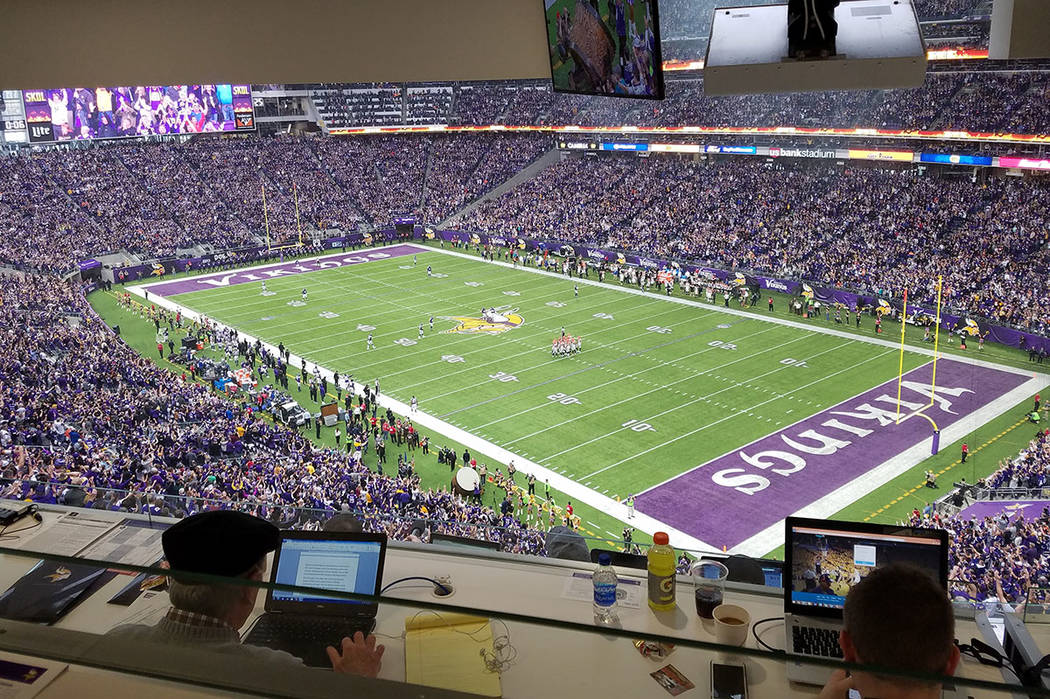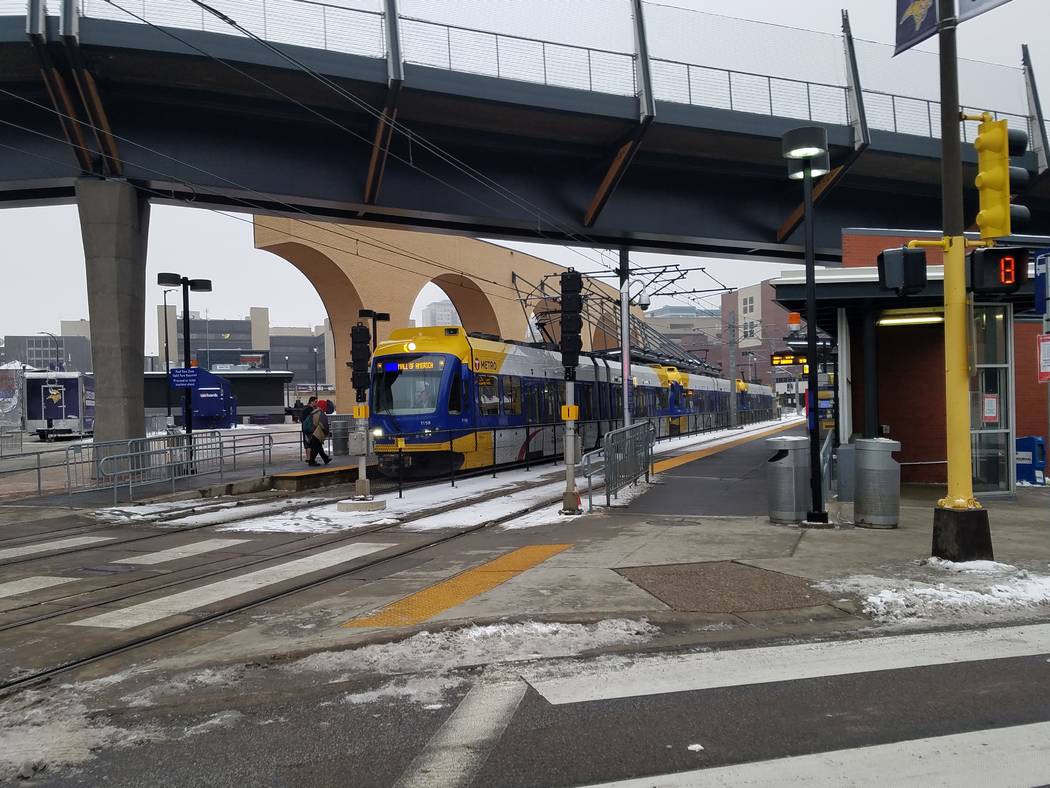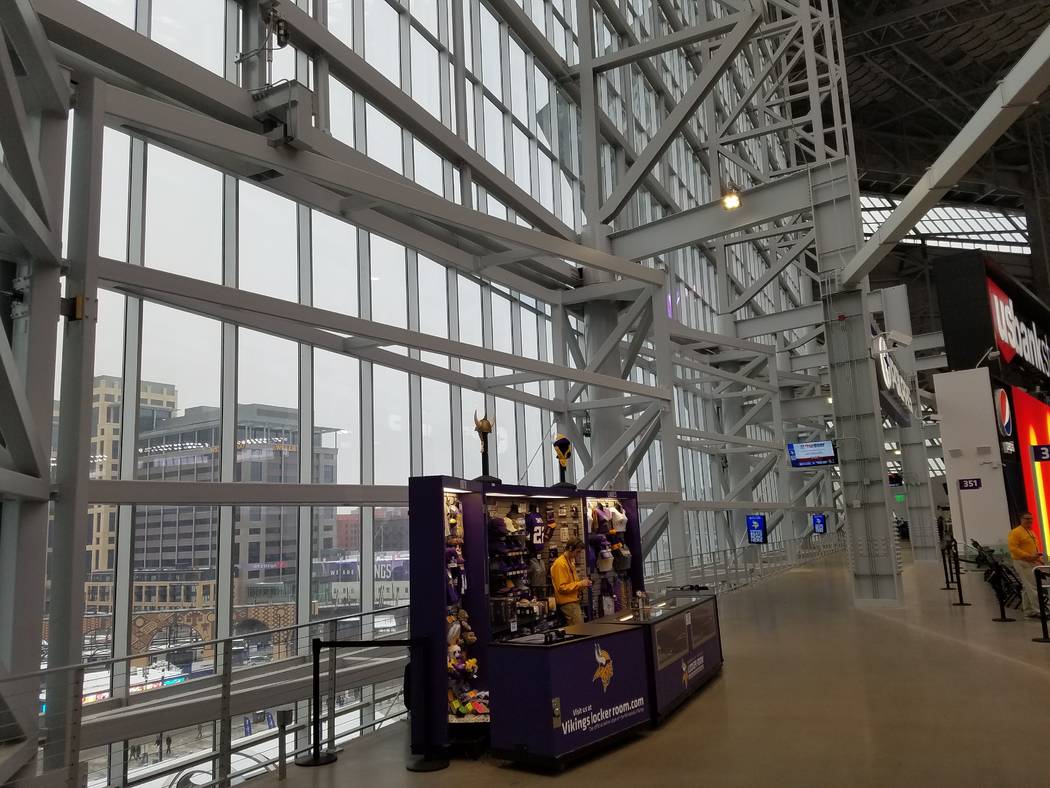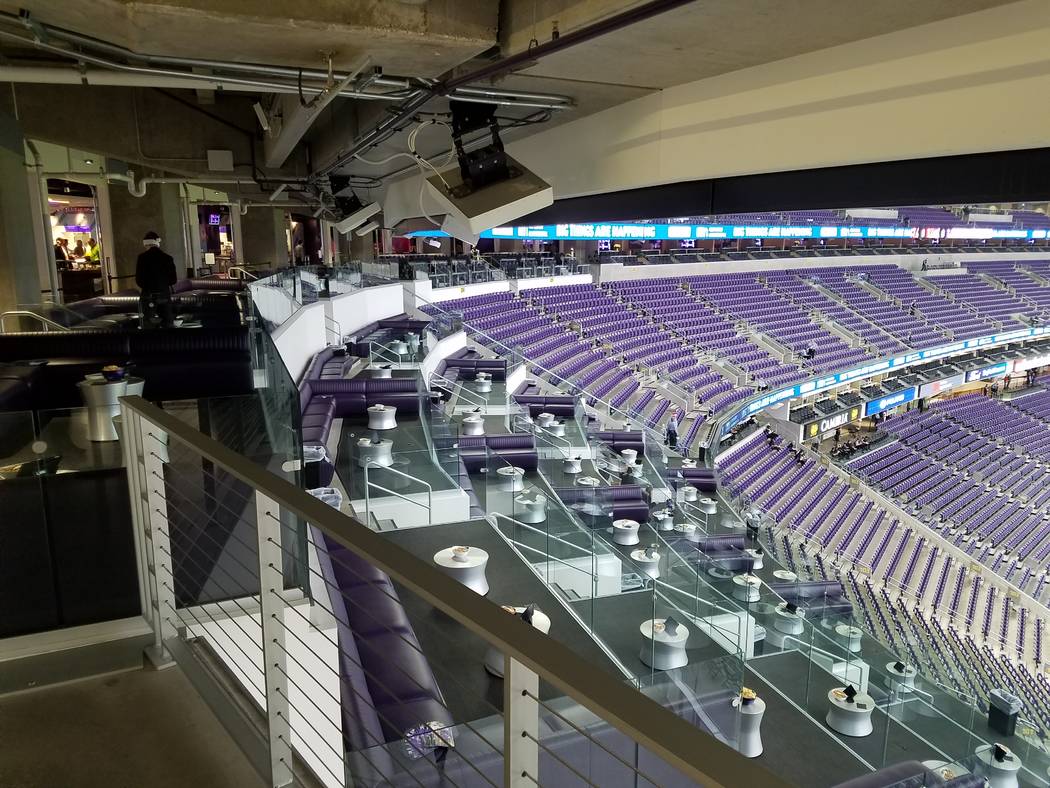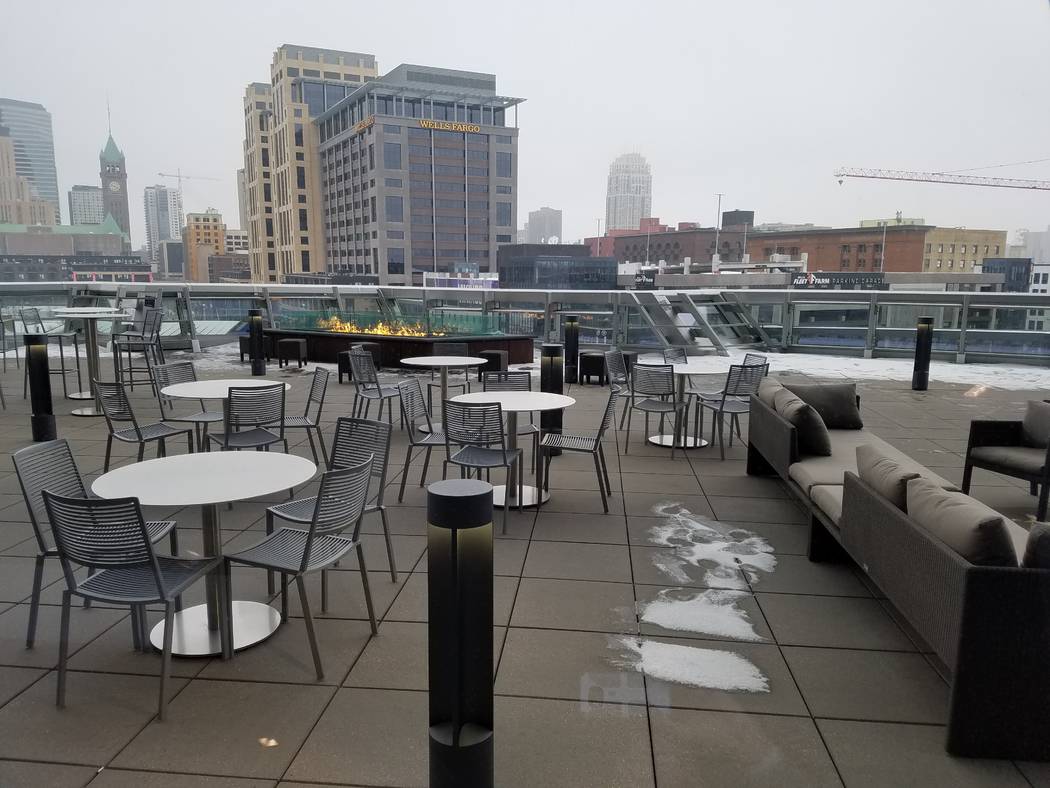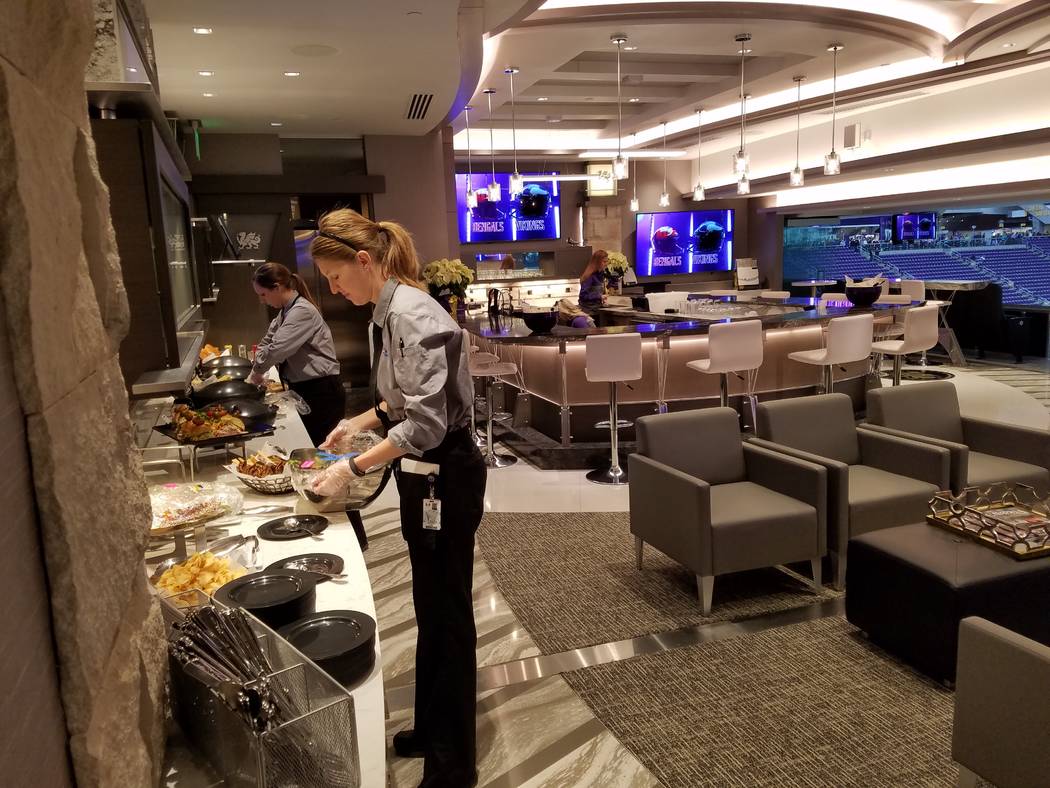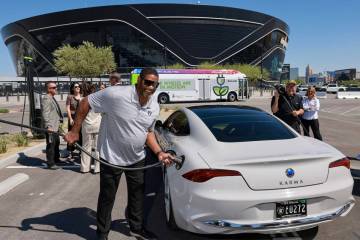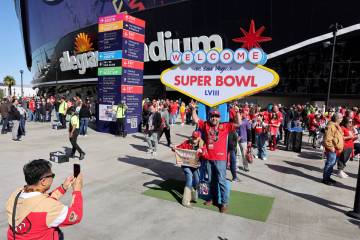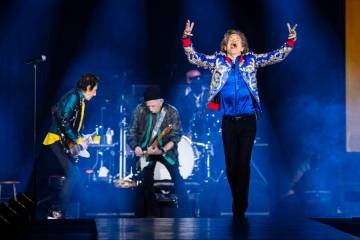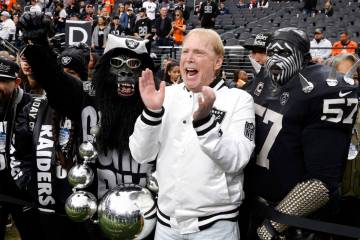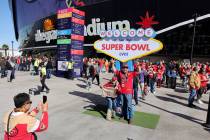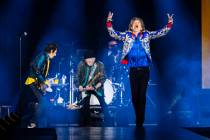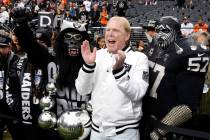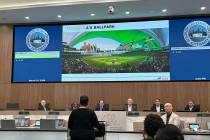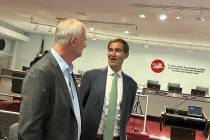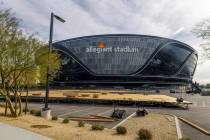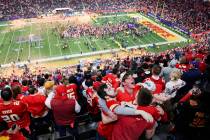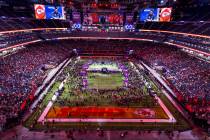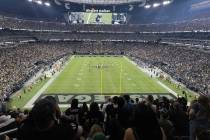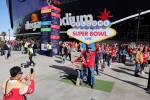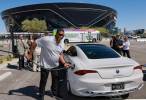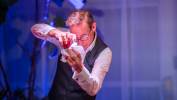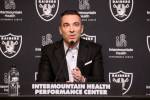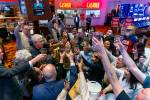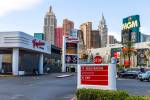Las Vegas stadium amenities may mirror those in Minneapolis
Editor’s note: This is the last in a series on how Minneapolis’ hosting of the Feb. 4 Super Bowl offers a guide for Las Vegas.
MINNEAPOLIS — It seems that every corner of U.S. Bank Stadium has some meaningful function that provides either an advantage to the hometown Minnesota Vikings or a hidden comfort designed to generate revenue.
It should be no different at the 65,000-seat Las Vegas stadium for the Raiders and UNLV Rebels, being built by the same contractor that assembled U.S. Bank Stadium, Mortenson Construction Co.
Have a look around U.S. Bank, and you will see:
— A bright and airy interior that almost looks like it’s outdoors, thanks to the ETF roof surface along the stadium’s south side. The lightweight roof allows natural light in and the angle of its pitch allows snow and ice to glide off into a gutter. The Las Vegas stadium will have that same rigid roof surface, which should make it seem like the game is outdoors.
— The exterior of U.S. Bank Stadium is reminiscent of a ship — maybe a Viking ship. The architect for Las Vegas’ stadium, David Manica, has said he wants the building to look sleek and fast, like a sports car. The ship design is perfect for the Vikings, a strong and powerful foe that conquers; the sports car look is envisioned to personify the Raiders’ speedy wide receivers.
— U.S. Bank has “pivot doors” on its west end that can be opened to allow autumn breezes in and provide an unencumbered view of the downtown Minneapolis skyline. The Las Vegas stadium will have a sliding door on its northeast end that will open to provide a killer view of the Strip. Look for that shot on telecasts, especially when the Raiders have those late Sunday games when the Strip lights come up.
— U.S. Bank Stadium has six sponsored club areas and lounges to serve a variety of high-end fans with experiences that range from comfortable party seating for the game to a field-level area where players emerge from the locker room before going onto the field. Players walk right through the center of the club. The path from the locker room is temporarily blocked off, just like a railroad crossing, as the players pass through and onto the field. A similar set-up is envisioned in Las Vegas.
— The Vikings have an on-field ship replica from which players emerge when introduced at the start of the game. A dragon on the ship’s prow snorts steam and belches fireballs into the air as each player runs onto the field when his name is announced. The Vikings have introduced a new fan-interactive “Skol!” chant to amp up the noise in support of the team. Watch for the Raiders to cook up some kind of hometown experience to put a charge into pregame festivities.
‘Exceeded expectations’
“I think the building has exceeded expectations,” said Lester Bagley, executive vice president of public affairs for the Minnesota Vikings.
“I think it’s the best building in the NFL.
“As you saw today, it provides a nice home-field advantage,” Bagley said after the Vikings toyed with the Cincinnati Bengals, defeating them 34-7 on Dec. 17. “It’s loud, it provides a lot of energy. It’s a great fan experience. I couldn’t be happier with where we’re at.”
Bagley says he sympathizes with the Raiders moving to a home where it’s likely that as many fans of visiting teams will be attending games.
“On the economic side, it’s good to have that,” Bagley said. “Lots of visiting teams will be bringing many partners, sponsors and fans on travel trips. So it’s good for the economics, maybe less so for the home-field advantage.”
But he acknowledged that Raiders fans are passionate about their team and they travel well. He expects the team to establish a loyal fan base, whether those fans are from Las Vegas or California, and to establish a loud environment in the domed venue.
The experience of going to a Vikings game starts with the getting there, and the decision to locate U.S. Bank Stadium at the former site of the Hubert H. Humphrey Metrodome was no accident. Parking schemes that had been in place for years didn’t have to change. Minneapolis’ light-rail system has a stop near the front entrance to the stadium, which Bagley said is the most urbanized in the NFL.
One-third use light rail
About one-third of people attending events at the stadium use the light-rail system, which costs $2 a ticket one way.
U.S. Bank has nearly no on-site parking, but the team has access to 3,500 spaces in an underground lot near the light-rail station.
Within a mile walk of the stadium are 40,000 spaces in parking garages scattered around downtown Minneapolis. On game days, parking goes for $45 to $50 per car.
Most of the parking garages are connected to the stadium via the Minneapolis Skyway, 11 miles of criss-crossing, climate-controlled overhead passages.
Parking is up in the air in Las Vegas — but not literally, like in Minneapolis.
Clark County codes require 16,250 parking spaces, but there is only room for about 2,400 on the 62 acres the team purchased for the stadium at Interstate 15 and Russell Road.
The Raiders repeated in January what they’ve said for months — that they’re exploring a number of off-site parking options. Those include land at the Bali Hai Golf Club, across I-15 and south of the stadium site, and other privately held land they would have to negotiate to use. But there won’t be any parking at UNLV, according to a proposed Joint-Use Agreement.
Tailgating important
The Raiders have indicated they’re not interested in developing a parking garage because they say the tailgating culture is too important to their fans and a parking garage wouldn’t work for tailgating.
Downtown Minneapolis is bicycle-friendly with a successful bike-share program in place, and there are dozens of bike parking racks along the stadium’s periphery.
As for the trek from parking or ground transportation to the stadium, the Raiders are committed to improving or adding pedestrian bridges over I-15. It’s expected that most people will park somewhere east of the freeway.
Video screens outside U.S. Bank Stadium provide information about the event inside. Likewise, an entire wall on the east side of the Las Vegas stadium will be a video screen, not unlike the screen at T-Mobile Arena that faces Toshiba Plaza.
Architects and designers of U.S. Bank Stadium believed they could maximize profitability inside the stadium by offering a greater variety of amenities. Dallas-based HKS Inc. knew that most NFL buildings provide eight to 12 price points for seating. The U.S. Bank design team set out to offer more than two dozen choices.
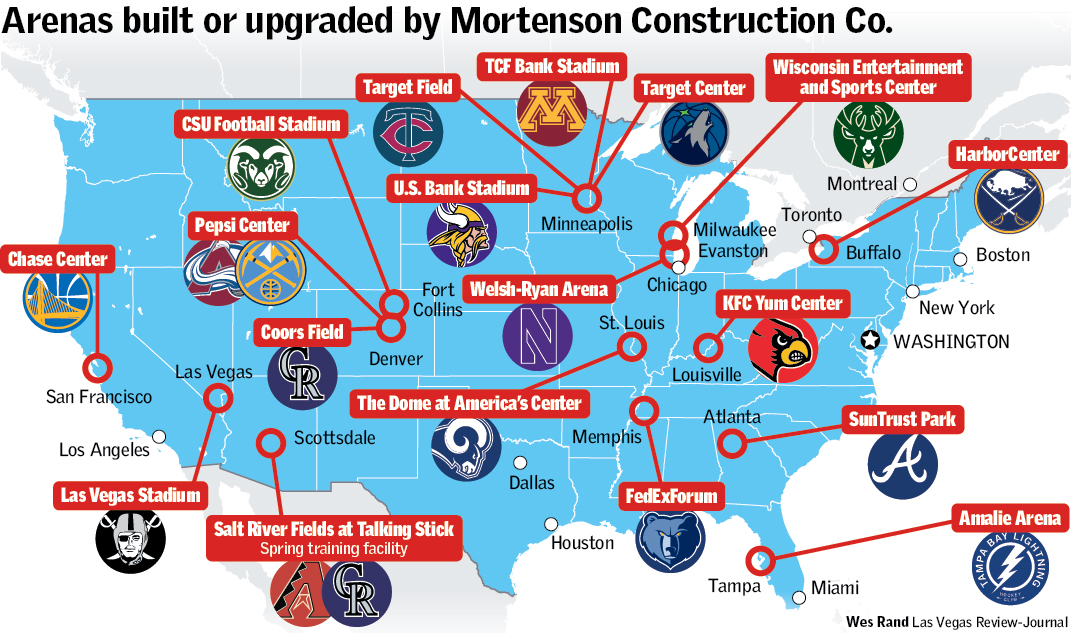
Choices are evident throughout the building. There are traditional stadium seats, multiple levels of club lounges, and suites.
Corporate support
Minneapolis is the corporate home of hundreds of companies, and, as in any new stadium project, outside companies also flocked to provide sponsorships and take advantage of brand visibility.
Medtronic, Ecolab, Pentair, Polaris, Hy-Vee, Land O’Lakes, Mystic Lake Casino, Delta Air Lines, Buffalo Wild Wings, Andersen Windows, Hyundai and Caribou Coffee were among the companies that bought into U.S. Bank Stadium.
While it’s still early for corporate sponsorships in Las Vegas, the line is expected to be long to corporately back the team as shown by T-Mobile Arena for the Vegas Golden Knights.
Six club lounges provide 8,200 club seats. There are 131 luxury suites on multiple levels of the stadium, some modified with products and features meeting the individual tastes of their owners.
Mystic Lake’s Club Purple has multiple bar areas and lounges and comfortable booth seats extending down the west end of the inner bowl. There are screens that provide fantasy football information, and on nice days, fans can go outside to a patio with a view of downtown Minneapolis.
The Delta Sky360 Club has food and drink a few feet from the field. That’s the club where players emerge from the locker room and cut through to the field. Fans can go up a flight of stairs for their sideline seats.
The high-end Medtronic Club has a vast dining area, multilevel bars, a big screen and two fireplaces.
On sunny days, fans in the Hyundai Club need to wear sunglasses because it’s so bright.
Lodge and Truss bars
The cheapest club seats are high above the east end zone. The Lodge Bar and the Truss Bar provides space for fans to connect during the game, stand and watch play. Four cabins are designed for group sales, and the team occasionally invites Viking greats of the past to mingle with fans.
The Raiders haven’t disclosed details of their club and seating schemes.
Public art is everywhere within the stadium, most of it with a football or Vikings theme.
Vikings Voyage, an interactive display of the team’s past and present, celebrates the team’s historic highlights. No doubt there will be a new entry after the Jan. 14 “Miracle in Minneapolis” playoff game against the New Orleans Saints.
Fans can sit with statues of the Vikings “Purple People Eaters” defensive front of the 1970s, don virtual-reality goggles to experience a game environment and test their speed against Viking players.
The Raiders have indicated they want to place a hall of fame in the Las Vegas stadium, but few details have emerged. Fourteen members of the Raiders have been enshrined in the Pro Football Hall of Fame.
Bagley said he believes the reason the Vikings’ projects have been successful is their willingness to keep the public apprised of progress. It’s a little different for the Raiders, who have one foot in Oakland, California, and one foot in Las Vegas. The team seems reluctant to provide many details, even at Stadium Authority meetings, to avoid alienating a fan base the team is abandoning in Oakland after returning there in 1995. Founded in 1960, the Raiders played in Oakland until 1982, relocating to Los Angeles for 13 seasons.
Bringing the public along
“One of the things we did as part of our process was to bring the public along,” Bagley said. “There was a fascination, a strong interest, in the market on the stadium development project, so we brought the public along. That excitement and the focus on the development of this incredible building was part of the communications plan intentionally. It also built support and energy for ticket sales.”
Bagley believes the Raiders eventually will take that course.
“It’s not rocket science. The Raiders know it. They’ll do it. They’ll be good at it,” he said. “Building that support, bringing it along, being transparent, bringing their fans and the public along on the development of their new stadium. It’s simple stuff, but I know they’re going to do a great job.”
Contact Richard N. Velotta at rvelotta@reviewjournal.com or 702-477-3893. Follow @RickVelotta on Twitter.
The series
(Part 1) Minnesota's Super Bowl bid holds lessons for Las Vegas
(Part 2) Raiders, Minnesota company unite to build Las Vegas stadium
(Part 3) Las Vegas Stadium Authority looks to Minnesota for guidance
U.S Bank Stadium by the numbers
2016 — The year the stadium opened
66,200 — Capacity in standard football configuration
70,000 — Expanded capacity
690 — ADA-compliant seats and companion seats
8,200 — Club seats
6 — Club lounges
131 — Luxury suites
430 — Points of sale
979 — Restroom fixtures
25,000 — Video board square footage
2,000 — High-definition televisions
1,300 — Wireless access points
11 — Elevators
33 — Escalators
2,500 — Premium parking spaces
$1.1 billion — Final cost to build stadium
$498 million (45.3%) — public contribution ($348 million from State of Minnesota and $150 million from City of Minneapolis)
37% — Percentage of workforce who are people of color (Goal: 32%)
9% — Percentage of workforce who are women (Goal: 6%)
4% — Percentage of workforce who are military veterans
12% — Percentage of minority-owned subcontracting firms (Goal: 12%)
16% — Percentage of women-owned subcontracting firms (Goal: 11%)



